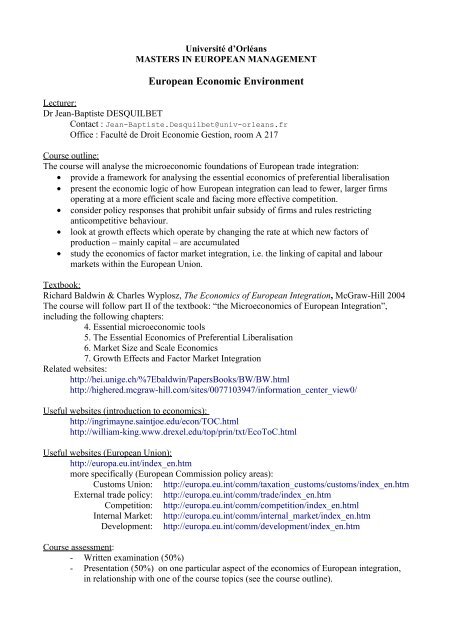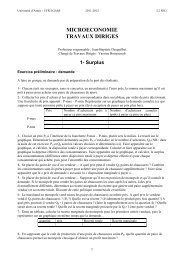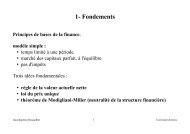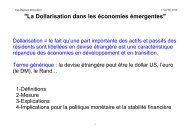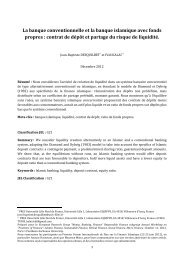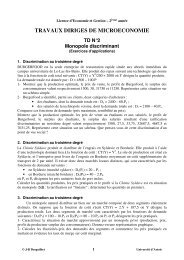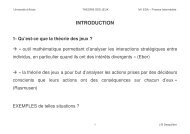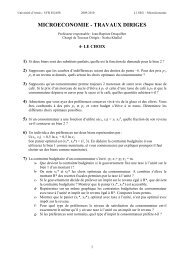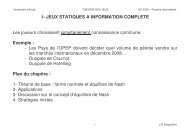Université d'Orléans - Jean-Baptiste Desquilbet
Université d'Orléans - Jean-Baptiste Desquilbet
Université d'Orléans - Jean-Baptiste Desquilbet
- No tags were found...
Create successful ePaper yourself
Turn your PDF publications into a flip-book with our unique Google optimized e-Paper software.
Université d’OrléansMASTERS IN EUROPEAN MANAGEMENTEuropean Economic EnvironmentLecturer:Dr <strong>Jean</strong>-<strong>Baptiste</strong> DESQUILBETContact : <strong>Jean</strong>-<strong>Baptiste</strong>.<strong>Desquilbet</strong>@univ-orleans.frOffice : Faculté de Droit Economie Gestion, room A 217Course outline:The course will analyse the microeconomic foundations of European trade integration:• provide a framework for analysing the essential economics of preferential liberalisation• present the economic logic of how European integration can lead to fewer, larger firmsoperating at a more efficient scale and facing more effective competition.• consider policy responses that prohibit unfair subsidy of firms and rules restrictinganticompetitive behaviour.• look at growth effects which operate by changing the rate at which new factors ofproduction – mainly capital – are accumulated• study the economics of factor market integration, i.e. the linking of capital and labourmarkets within the European Union.Textbook:Richard Baldwin & Charles Wyplosz, The Economics of European Integration, McGraw-Hill 2004The course will follow part II of the textbook: “the Microeconomics of European Integration”,including the following chapters:4. Essential microeconomic tools5. The Essential Economics of Preferential Liberalisation6. Market Size and Scale Economics7. Growth Effects and Factor Market IntegrationRelated websites:http://hei.unige.ch/%7Ebaldwin/PapersBooks/BW/BW.htmlhttp://highered.mcgraw-hill.com/sites/0077103947/information_center_view0/Useful websites (introduction to economics):http://ingrimayne.saintjoe.edu/econ/TOC.htmlhttp://william-king.www.drexel.edu/top/prin/txt/EcoToC.htmlUseful websites (European Union):http://europa.eu.int/index_en.htmmore specifically (European Commission policy areas):Customs Union: http://europa.eu.int/comm/taxation_customs/customs/index_en.htmExternal trade policy: http://europa.eu.int/comm/trade/index_en.htmCompetition: http://europa.eu.int/comm/competition/index_en.htmlInternal Market: http://europa.eu.int/comm/internal_market/index_en.htmDevelopment: http://europa.eu.int/comm/development/index_en.htmCourse assessment:- Written examination (50%)- Presentation (50%) on one particular aspect of the economics of European integration,in relationship with one of the course topics (see the course outline).
Université d’OrléansD.U. IN EUROPEAN MANAGEMENT2005-2006European Economic EnvironmentFINAL EXAMLecturer: <strong>Jean</strong>-<strong>Baptiste</strong> <strong>Desquilbet</strong>2 hours – printed documents allowed1- Using the figure below, which summarizes the NIC-NIR model of preferential liberalization withsymmetric countries, including the initial MFN tariff :Border priceBorder priceDomestic price• Show theMS MFNimpactXS RofXS PMS FTMDRoWExportsPartnerExportsHomeImports“Partner” and “Home” forming a customs union that keeps the initial tariff constant. Discusscarefully which economic “agents” (consumers, firms, governments, countries…) gain or lose.• Assume that “Partner” and “Home” form a customs union and lower their common external tariff tothe point where the new border price facing RoW exporters is the same as initially. Show that“Partner” and “Home” gain while “RoW” does not lose from this CU-with-CET-reduction scheme.• Using the economic logic of this model, explain why most trade liberalizations are reciprocal ratherthan unilateral.2- Using the analytical tools introduced to study the “Market size and scale effects”, comment onthe following statement about the European Commission competition policy. Draw any figure youthink appropriate.“By giving certain firms or products favoured treatment to the detriment of other firms or products,state aid seriously disrupts normal competitive forces. Neither the beneficiaries of state aid northeir competitors prosper in the long term. Very often, all public subsidies achieve is to delayinevitable restructuring operations without helping the recipient actually to return tocompetitiveness. Unsubsidised firms who must compete with those receiving public support mayultimately run into difficulties, causing loss of competitiveness and endangering the jobs of theiremployees. Ultimately, then, the entire market will suffer from state aid, and the generalcompetitiveness of the European economy is imperilled.State aid that distorts competition in the Common Market is prohibited by the EC Treaty.”Source: http://europa.eu.int/comm/competition/state_aid/overview/
Université d’OrléansMASTER IN EUROPEAN MANAGEMENT2004-2005European Economic EnvironmentFINAL EXAMLecturer: <strong>Jean</strong>-<strong>Baptiste</strong> <strong>Desquilbet</strong>2 hours – documents allowed1- Using the “essential economics of preferential liberalization”, comment on the following pressrelease from the European Commission. You will show the effects on EU countries, on partnercountries that previously benefited from preferential trade agreements (e.g. Mediterraneancountries) and on the Rest of the World, especially China and India, who are said to havedramatically low production costs. Draw any figure you think appropriate.The EU to lift textiles quotas from 1 January 2005Brussels, 13 th December 2004Today the Council adopted a Commission proposal for a Regulation that will eliminate from 1st January2005 all quantitative restrictions on the import of textile and clothing products from WTO countries. ThisRegulation implements one of the key commitments taken at the end of the last WTO Trade Round(“Uruguay Round”) in 1994. “This definitively seals the disappearance of textiles quotas that have been inplace for four decades and there is no going back”, declared EU Trade Commissioner Peter Mandelson.“The challenge now for the textiles industry world-wide is to compete in the new environment. But policymakers also need to ensure that the transition is as smooth as possible and managed in a way that does notwipe out the textiles industries of weak and vulnerable developing countries. They too should be able tobenefit from liberalisation in due course”, he added.2- Using the analytical tools introduced to study the “Market size and scale effects”, comment onthe following overview of the European competition policy. You will especially show the expectedbenefits of liberalization, and discuss the pros and cons of state aid. Draw any figure you thinkappropriate.European competition policy : a brief overview - LiberalisationThe term liberalisation refers to Article 3 of the EU Treaty which states that the "activities of the Communityshall include (...) g) a system ensuring that competition in the internal market is not distorted". For thispurpose, Article 86(3) of the EU Treaty entrusts the Commission with a specific surveillance duty "in thecase of public undertakings and undertakings to which Member States grant special or exclusive rights".[…] Since 1980 the Commission adopted directives under Article 86(3), on the one hand, to rendertransparent the financial relations between the Member States and their public companies and, on the other,to liberalise the electronic communications markets. These directives specify the obligations of the MemberStates resulting from the Treaty in the relevant area. The directives do, in principle, not create newsubstantive obligations. Where Member States do not comply with such directives, the Commission initiatesinfringement procedure under Article 226 of the EU Treaty against the relevant Member States.(source: http://europa.eu.int/comm/competition/liberalization/overview/)


